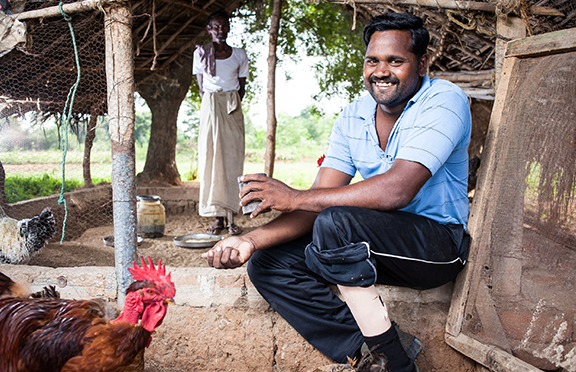Hatching a Plan for His Peers
My Story
As a young boy growing up in Settianthal village, in Tiruvannamalai district of Tamil Nadu, I had ambitions to join the army and follow in the footsteps of my father and elder brothers.
In my last year in school, my right leg was amputated after a road accident. This dashed my dreams of joining the army.
I became despondent and depressed. I refused to study further after completing school.
To lift my spirits, my family encouraged me to go out of the house, hang out with others, and occasionally attend the social service meetings in the village. I would try and get out just so that I wouldn’t sit and mope. This proved to be the turning point.
I started attending village development meetings and volunteered to help others. This brought me to the notice of SST. They began befriending me and were very patient with me. They would try and tell me that despite my injury, I could lead a better, more productive life and do something of my own.
I didn’t believe them at first.
At one of the village development meetings, they suggested I take up poultry farming and become self-employed. I eventually agreed after my parents offered to lend me some money to get the business going. I built a poultry shed in the compound of their house and bought 50 chicks for Rs. 2,500.
Within three months, I was able to use my profit of Rs. 8,000 to buy 150 chicks. In four months, I managed to earn Rs. 53,000.
My success has boosted my confidence. I now try to encourage others who are disabled to start their own business.
The SST Way
SST social worker Paramasivan who mentored Murthy
Murthy had a disability and was lacking in confidence. He had no self-belief. We used to observe him at village meetings and felt we should do something. When SST approached him, he didn’t show much interest. He used to say, ”I can’t do anything. Nobody will help. Talk to somebody else because I am of no use,” and so on.
I started frequenting the place where he would turn up to watch other boys in the village play volleyball and sit next to him and talk. I would point out to each of the boys playing and spell out what their plans were, and what they were aiming to become in life.
SST workers felt that Murthy could work from home. SST would steer talk toward livestock and discuss what Murthy could achieve. Murthy’s parents were also worried about their son. So, SST would give separate counselling to his parents. The aim was to convince them that their son can work and that they all could make this happen with some help.
Murthy’s mother was part of a self-help group of 15 people, and she knew about SST, and trusted us.
SST asked Murthy to buy 10 chicks for Rs. 50 each. Within four months and during the Deepavali festive season, he managed to sell 500 of these. He earned a steady income without much effort. Today, things are different.
Murthy has also got married. He now has a large 120-foot shed to house 5,000 broiler chickens that he purchased. Murthy still attends village meetings and plays a supervisory role when time permits. He has become a role model for others and is an inspiration.
For me, Murthy’s example is truly impactful. His transformation is what they call in Tamil, adhbudha velai, or an extraordinary achievement.
Our Takeaways
We adopt a group of 15 families and we steer clear of political parties and groups.
We use existing government infrastructure and spruce up buildings and facilities that are not being used.
Typically, villagers are always suspicious because they may have had bad experiences with people posing as social workers and duping them. So it takes a lot of patience and trust to get their buy-in.
We often begin work slowly with self-help groups, and that could take a year. It’s all about conducting oneself with honesty and earning trust.
